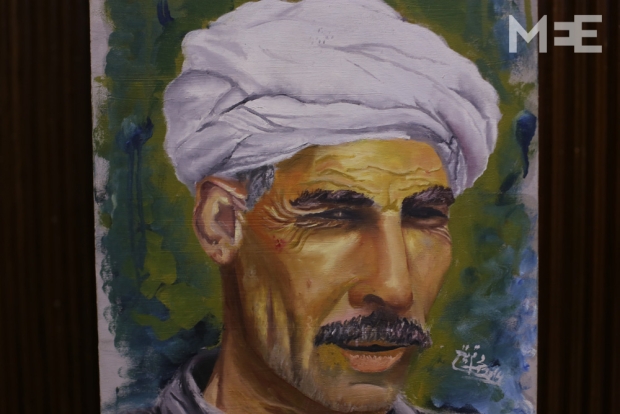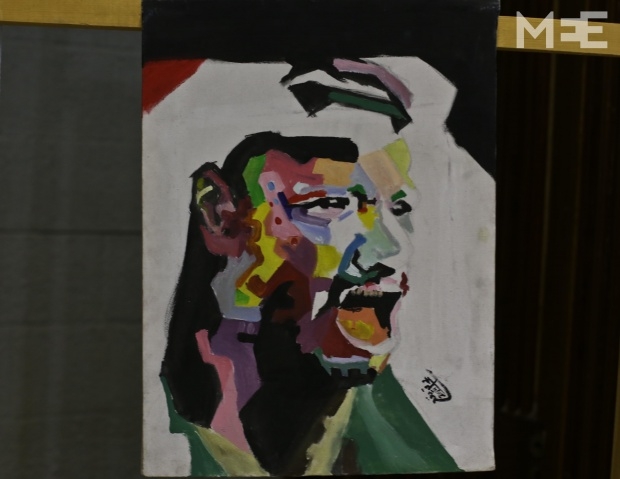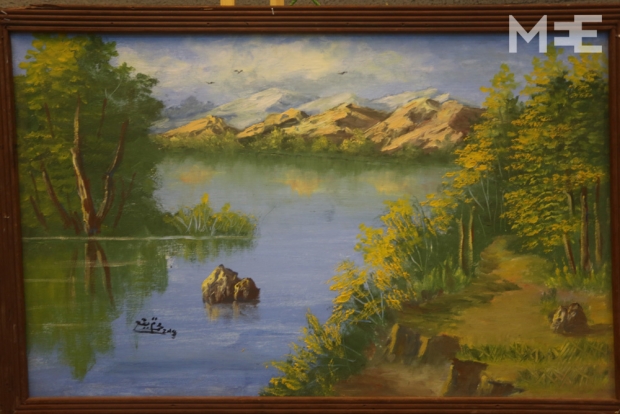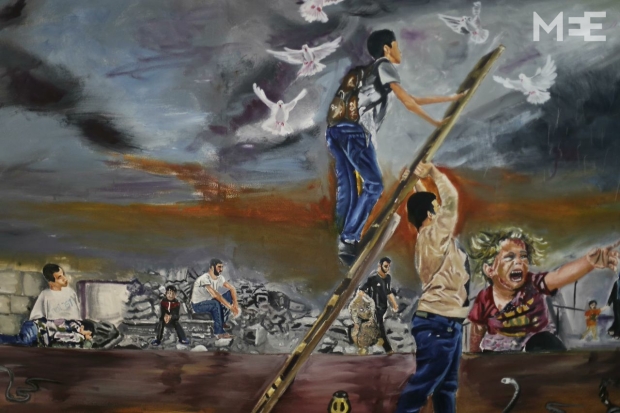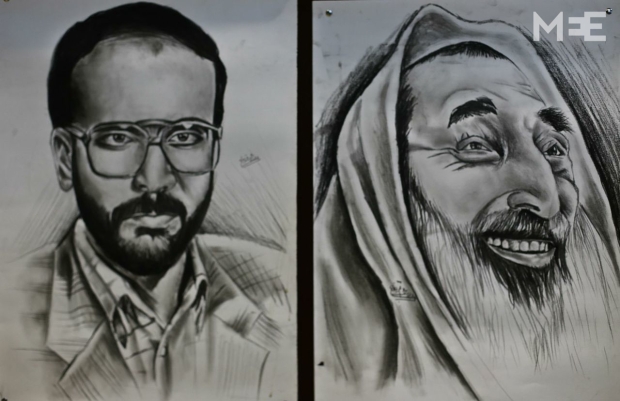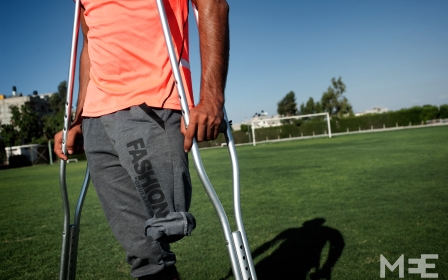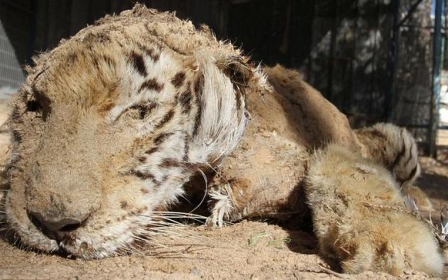The young 'Picasso of Palestine'

A wide smile spreads across the tiny face of 13 year old Mohammed Qraiqae as he looks at the range of art materials spread out in his hands and those neatly mounted on the wall beside him.
Mohammed’s tiny fingers seem to know instinctively how to master every piece of art that springs almost spontaneously to life at his fingertips.
Whether they are the curves and wrinkles that line the face of an old Palestinian woman or one of his more abstract pieces, people are always impressed with his attention to detail and his eye for interesting subject material.
At the tender age of five, Mohammed started to follow in the footsteps of his older brother Malek Qraiqae and began to paint; a skill that he has honed so well that he is now celebrated locally as the "Picasso of Palestine". This is a nickname he earned not necessarily because he follows the same artistic traditions as the Spanish artist, although his abstract style is reminiscent of his from time to time, but more as a nod to the quality and calibre of the work he is producing. (It's also possibly a passing reference to the fact that Mohammed paints with his left hand - and some believe Picasso may also have been left handed).
"I am a quiet boy, and reflect my madness only in my paintings" he says, as his deft fingers travel swiftly over the canvas.
Social media has made it easier for Mohammed to expand his work and reach out to people beyond the besieged Gaza Strip.
"I never really thought of the importance that social media plays in transmitting one's thoughts to others," he says. He is becoming increasingly aware of it, though, and exhibitions of his work have already been shown in several countries, from Turkey and Iran to Tunisia where he was met by state officials.
The Israeli-imposed siege on Gaza makes travel outside the strip nearly impossible for most, but Mohammed has been lucky to have had help securing visas through his supporters. He was also able to travel abroad during a brief ceasefire in the war last year. Sadly, though, his talent seems lost on his own Palestinian officials who have paid scant attention to what the boy is able to do, or the attention he is gaining around the Middle East.
"I have never received any encouragement from my own government in Palestine," Mohammed told the Middle East Eye wistfully. He attributes this lack of attention to the fact that the government, itself, has such limited resources.
Mohammed lives in the Shejaiya refugee camp, one of the residential neighbourhoods that was decimated during the 2014 summer of violence which killed over 2,100 Palestinians in Gaza. Many of those killed were from his neighbourhood.
In addition to the fear he felt for the lives of family and friends, Mohammed confesses that, amidst the bombings over the summer, he also was constantly worried about his artwork, fearful that his paintings would be destroyed by the random shelling that was crashing down on Shejaiya.
He said he realises that looking at destruction is one part of the narrative, but it should by no means be the only one, and he, therefore, continues to reflect on sunnier images of Gaza, too. Even if he does not see these happier images when he observes his reality, he can, at least, portray what he dreams for his homeland in his art.
"Through art, we can be ambassadors to the world! One painting can capture the hearts of millions," says the 13 year old boy with the wide smile, as he continues painting his canvas with intensity.
His art has been affected by the various stages of his young life. In his 13 years he has already lived through three devastating wars: those of 2006, 2012, and 2014.
"I love painting, even when I have no paints. When paints were not allowed to come through into Gaza, I used coffee, sand and glue as an alternative," he says grinning.
Even when the art supplies are available in Gaza, they are so expensive that he often struggles to afford them. "I buy oil colours for 45 NIS (New Israeli Shekels) (approx £7.64). That's double the price of anywhere else in the world, and the product is of lower quality too."
But the more Mohammed paints, the more he creates a name for himself, and the more that happens, the more art supplies he can afford. He now sells portraits of people to help him pay for his materials.
Mohammed often receives requests from buyers who want to purchase his art, but as Gaza continues to suffer restrictions on movement and access he, more often than not, ends up being unable to send his materials abroad. Shipping companies are only functioning to send essential items, where mail has to go from Gaza to the West Bank or Israel and then abroad.
Another advantage of his growing fame is that, over the years the young "Picasso of Palestine" has been able to participate in competitions, often with adults, and often in which the public is blown away by his talent.
This is vital because, for Mohammed, art is a way of lobbying for the Palestinian cause. He wants his fans to learn to love Gaza and to become supporters of the Gaza cause.
"I see that fans can become defenders for our dreams and hopes," he says, broadly smiling as his older brother Malek watches him put the final, careful touches on the picturesque scene in front of him.
Never one to shy away from a challenge, Mohammed is taking on yet another - securing a Guinness World Record – in which he will need to create 100 portraits in a single week.
Most of his portraits are of Palestinian national figures. He likes to use a combination of oil paintings and sketches and so many of those he will create will likely follow that model.
Mohammed certainly wants to be remembered for his art, but he says he also wants to leave a legacy behind on behalf of all Palestinian children. "My dream is to become an ambassador on behalf of all Palestinian children one day."
A dream he is already well on the way to making a reality.
Middle East Eye propose une couverture et une analyse indépendantes et incomparables du Moyen-Orient, de l’Afrique du Nord et d’autres régions du monde. Pour en savoir plus sur la reprise de ce contenu et les frais qui s’appliquent, veuillez remplir ce formulaire [en anglais]. Pour en savoir plus sur MEE, cliquez ici [en anglais].


